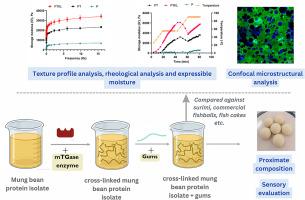k-卡拉胶、刺槐豆胶和转谷氨酰胺酶对植物基鱼丸类似物的结构和流变特性的影响
IF 8.2
Q1 FOOD SCIENCE & TECHNOLOGY
引用次数: 0
摘要
以植物蛋白为基础的鱼丸类似物有可能促进可持续和替代蛋白质来源,有助于减轻过度捕捞的负担。然而,缺乏能与商业鱼丸在感官和营养上相媲美的产品。本研究评价了微生物谷氨酰胺转胺酶和水胶体的添加对绿豆蛋白鱼丸的质地、微观结构和感官特性的影响。添加1%的mTGase可显著改善其织构和保水能力,将可表达水分降至24%,硬度提高至474.69 g. κ-卡拉胶(0.3%)进一步增强了这些性能,可表达水分为19.55%,硬度为794.16 g。添加0.13%的刺槐豆胶和1%的mTGase可提高凝胶的可表达水分,降低凝胶硬度。营养分析显示,与传统的鱼糜制品相比,添加0.3% κ-卡拉胶、1% mTGase和0.13% LBG的绿豆蛋白鱼丸具有较高的蛋白质含量(12.3 g)和较低的碳水化合物含量(3 g)。61名参与者的感官评估显示,绿豆蛋白鱼丸的可接受性很高,外观平均得分为6.38分,质地平均得分为6.08分,整体喜欢度平均得分为6.02分。结果表明,经mTGase、LBG和κ-卡拉胶优化的绿豆蛋白鱼丸是一种营养丰富、有吸引力的植物性替代品,满足了消费者对健康和可持续食品选择的偏好。本文章由计算机程序翻译,如有差异,请以英文原文为准。

Roles of k-carrageenan, locust bean gum, and transglutaminase on textural and rheological characteristics of plant-based fishball analogues
Plant protein-based fishball analogues have the potential to contribute to sustainable and alternative protein sources, helping to alleviate the burden of overfishing. However, there is a lack of products that are sensory and nutritionally comparable to commercial fishballs. This study evaluated the impact of mTGase (microbial transglutaminase) and hydrocolloid addition on the texture, microstructure, and sensory properties of mung bean protein-based fishballs. The addition of 1 % mTGase significantly improved texture and water-holding capacity, reducing expressible moisture to 24 % and increasing hardness to 474.69 g. κ-Carrageenan (0.3 %) further enhanced these properties with expressible moisture at 19.55 % and hardness at 794.16 g. The addition of 0.13 % LBG (locust bean gum) with 1 % mTGase increased expressible moisture and reduced gel hardness. Nutritional analysis of mung bean protein-based fishballs formulated with 0.3 % κ-carrageenan, 1 % mTGase, and 0.13 % LBG revealed a higher protein content (12.3 g) and lower carbohydrate content (3 g) compared to conventional surimi products. Sensory evaluation with 61 participants showed high acceptability for mung bean protein-based fishballs, with mean scores of 6.38 for appearance, 6.08 for texture, and 6.02 for overall liking. The results suggest that mung bean protein-based fishballs, optimized with mTGase, LBG, and κ-carrageenan, offer a nutritious and appealing plant-based alternative, meeting consumer preferences for healthy and sustainable food options.
求助全文
通过发布文献求助,成功后即可免费获取论文全文。
去求助
来源期刊

Future Foods
Agricultural and Biological Sciences-Food Science
CiteScore
8.60
自引率
0.00%
发文量
97
审稿时长
15 weeks
期刊介绍:
Future Foods is a specialized journal that is dedicated to tackling the challenges posed by climate change and the need for sustainability in the realm of food production. The journal recognizes the imperative to transform current food manufacturing and consumption practices to meet the dietary needs of a burgeoning global population while simultaneously curbing environmental degradation.
The mission of Future Foods is to disseminate research that aligns with the goal of fostering the development of innovative technologies and alternative food sources to establish more sustainable food systems. The journal is committed to publishing high-quality, peer-reviewed articles that contribute to the advancement of sustainable food practices.
Abstracting and indexing:
Scopus
Directory of Open Access Journals (DOAJ)
Emerging Sources Citation Index (ESCI)
SCImago Journal Rank (SJR)
SNIP
 求助内容:
求助内容: 应助结果提醒方式:
应助结果提醒方式:


